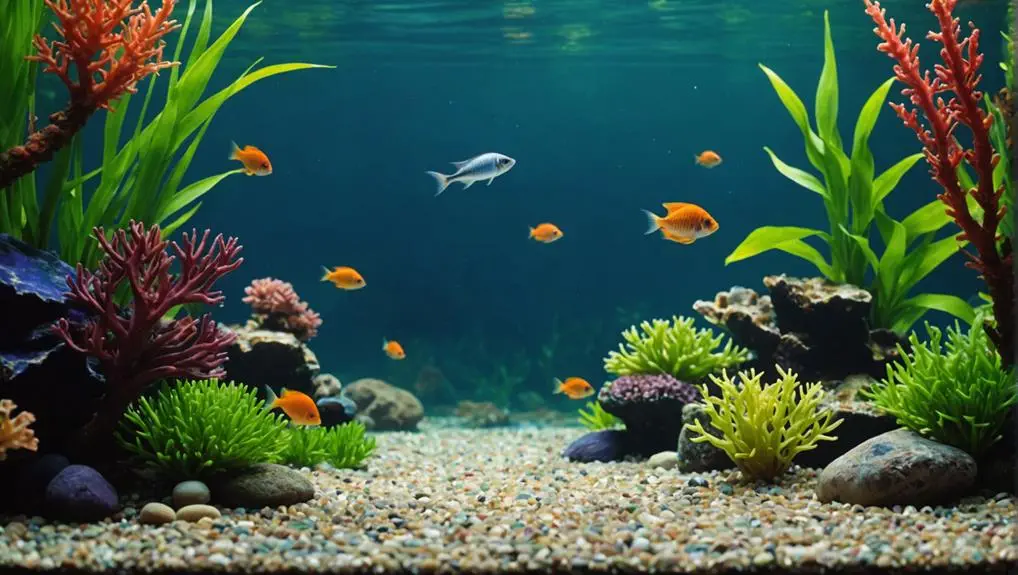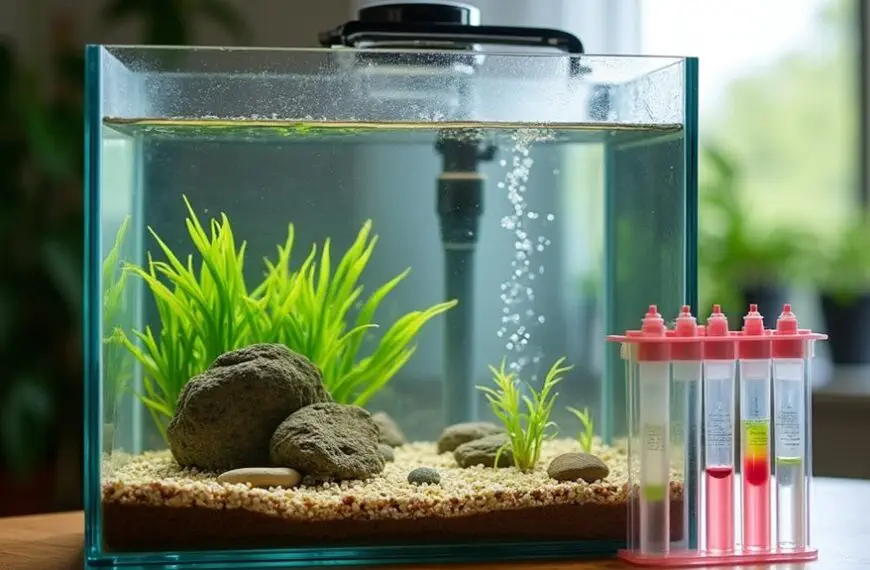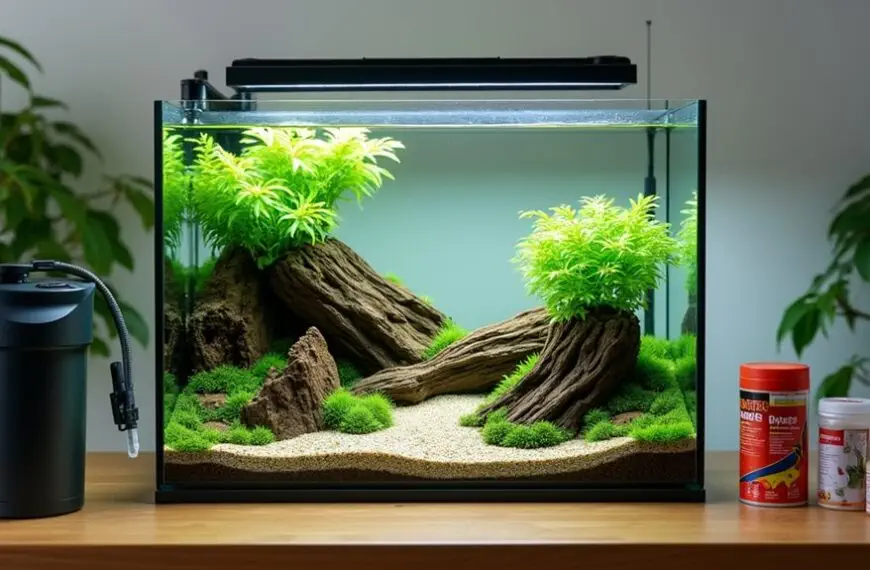Setting up your perfect fish tank is all about creating a cozy home for your aquatic pals. First, choose a tank size that fits your space—bigger is usually better! Make sure it has proper equipment like a filter, heater, and good lighting. Rinse everything before filling the tank with treated water. Don't forget to add some nice plants and decorations for your fish to explore. After cycling the tank to build beneficial bacteria, you can introduce fish gradually. Keep an eye on water quality and fish health. Excited to get started? Plenty more tips are waiting for you!
Contents
Choosing the Right Tank Size
When it comes to choosing the right tank size, remember that larger tanks—20 gallons or more—offer more stability in water quality, making them easier to maintain. If you're looking to create a thriving freshwater tank, a larger aquarium is your best bet.
Smaller tanks, around 10 gallons or less, can be tricky, requiring more frequent maintenance due to rapid fluctuations in water parameters.
When you're thinking about adding fish, keep in mind the common guideline of one inch of fish per gallon. This means if you have a 20-gallon tank, you can ideally add 20 inches of fish. However, it's essential to adjust this rule based on the specific needs of your fish species.
Some fish love to swim in schools, so if you're going for group-oriented types, aim for at least six of them, which will need even more space.
Choosing the appropriate amount of tank size isn't just about numbers. It's about creating a comfortable home for your fish, ensuring they're happy and healthy. Plus, you'll find it's much more enjoyable to watch them swim in a spacious environment!
Essential Equipment for Setup
Setting up your fish tank is like preparing for a big adventure, and having the right gear is essential!
You'll need to gather supplies like a sturdy tank, a quality filter, and a heater, all of which play crucial roles in keeping your fish happy and healthy.
Plus, while it might feel like a bit of an investment, think of it as setting up a cozy home for your aquatic friends—after all, who doesn't want the best for their underwater buddies?
Necessary Supplies Overview
A well-equipped fish tank starts with a few essential supplies that ensure a successful setup. First up, you'll need a sturdy lid to keep your aquatic friends safe from jumping out.
Next, grab a heater—preferably an adjustable one for tropical fish—because nobody likes a chilly swim! You can't forget a good filter; sponge filters are beginner-friendly and do a great job keeping the water clean.
Now, let's talk substrate. You have options like gravel or sand for the tank flooring. Gravel offers a rainbow of colors, while sand is perfect for bottom feeders.
Just remember to rinse these materials before adding them, or you'll end up with a cloudy mess.
Don't overlook water conditioner—it's crucial for removing toxins and making your fish feel right at home.
And for maintenance, a tank siphon will be your best friend, making cleaning a breeze.
With these necessary supplies, you're well on your way to creating a vibrant and healthy environment for your fish.
Equipment Functionality Importance
Five essential pieces of equipment play a crucial role in ensuring your fish tank thrives.
Each one contributes to creating a safe and healthy environment for your aquatic friends.
Let's dive into what you'll need:
- Aquarium filter: This keeps your water clear and removes toxins, ideally filtering double the tank volume per hour.
- Reliable heater: Tropical fish need warmth! Keeping the temperature between 74°F and 80°F supports their health and energy.
- Quality substrate: Gravel encourages beneficial bacteria growth, while sand works better for fish that love to burrow. Choose wisely based on your fish's needs.
- Aquarium lid: It's not just for looks. A good lid minimizes heat and water loss, and keeps your fish from making a leap for freedom.
- Lighting: Quality LED lights help your plants grow and mimic day-night cycles, enhancing both the beauty of your tank and your fish's wellbeing.
Cost Considerations for Setup
When budgeting for your fish tank, expect to spend at least $200 for essential supplies, as hidden costs can quickly add up.
You'll need an appropriately sized aquarium, a lid, a heater, a filter, and lighting. Remember, larger tanks can be more cost-effective due to better chemical dilution.
But don't forget about those extra expenses! Water conditioning products, substrate, decorations, food, and replacement filters all contribute to your initial setups.
As you dive into this fishy adventure, consider investing in high-quality equipment like LED lights and sponge filters. They're efficient and easier to maintain, especially for beginners.
Don't let the initial cost scare you; think of it as an investment in your aquatic friends' happiness.
Now, let's talk annual costs. Maintaining your aquarium can average around $100 each year, factoring in consumables like food and replacement filter media.
This emphasizes the importance of ongoing budget planning. By keeping track of these cost considerations, you'll ensure your fish tank remains a joyful and affordable hobby.
Plus, your fish will thank you for it—who wouldn't want a happy home?
Location and Placement Tips

When you're picking the perfect spot for your fish tank, remember to steer clear of direct sunlight; your fish don't need a sunbathing session!
Make sure the floor can handle the weight of the tank when it's filled up—water is surprisingly heavy, and you don't want a surprise flood.
Lastly, check for enough electrical outlets nearby, so you can keep everything running smoothly without having to play musical chairs with your plugs.
Avoid Direct Sunlight
Placing your aquarium in a spot that avoids direct sunlight is crucial for maintaining a healthy environment for your fish.
Too much sunlight can lead to excessive algae growth, which not only looks unattractive but can also disrupt the delicate balance of your freshwater aquarium. You want to ensure stable water temperatures, so keep your tank away from heat vents, air conditioners, or windows that can cause temperature fluctuations.
Here are some tips to help you choose the perfect location:
- Avoid direct sunlight to reduce algae growth.
- Select a flat, waterproof surface for support and to prevent spills.
- Position the tank away from high traffic areas to minimize stress on your fish.
- Keep the tank near at least three electrical outlets for your equipment needs.
- Regularly conduct water testing to monitor the health of your aquarium.
Check Floor Support
Ensuring your floor can support the weight of a full aquarium is essential for a successful setup. Water weighs about 8 pounds per gallon, and when you add substrate and decorations, that can add up quickly!
So, before you set up your tank, check floor support. Take a moment to measure your aquarium's dimensions and calculate the total weight. This way, you'll know if your chosen location can handle it safely.
It's crucial to place your aquarium on a level, flat surface. This helps avoid pressure points that could lead to cracks or leaks—trust me, you don't want a surprise water feature in your living room!
And steer clear of soft or pliable materials; they can create instability and uneven weight distribution.
If you're renting, it's also wise to check your rental agreement for any restrictions on tank size or placement. You wouldn't want to face any conflicts with your landlord down the line.
Ensure Electrical Access
How will you power your aquarium setup without a hassle? First, ensure you've got at least three electrical outlets nearby for your tank. You'll need one for the filter, another for the heater, and one for lighting. Trust me, you'll thank yourself later when everything runs smoothly!
Here are some location and placement tips to keep in mind:
- Choose a stable, dry floor that can handle the weight of a full tank—about 8 lbs per gallon!
- Avoid heat vents, air conditioners, or windows to prevent temperature fluctuations that could stress your fish.
- Make sure your power source is easily accessible for maintenance but out of reach of potential spills. We all know accidents happen!
- Manage your electrical cords safely to prevent tripping hazards, and keep your space looking tidy.
- Label your outlets for easy identification; it'll save you from a mini panic during emergencies!
Taking these steps ensures you're set up for success while creating a safe and inviting home for your aquatic friends. Happy tanking!
Preparing the Tank
To prepare your fish tank effectively, start by rinsing it with warm water to remove any debris or dust. Avoid using soaps or cleaning agents; they can harm your aquatic friends.
Next, place the tank on a flat, waterproof surface to ensure stability. Remember, water weighs about 8 lbs per gallon, so check the floor's support to avoid any mishaps!
Once your tank's in place, it's time to arrange the substrate at the bottom. Make sure to create a smooth surface, which will help plant roots settle in nicely and keep your tank looking sharp.
After that, fill the tank with water—don't worry, it'll look stunning soon!
Now, here's a crucial step: add a water conditioner to detoxify the tap water. This ensures your fish will have a safe and welcoming environment.
Once filled with water, wait 24-48 hours for the water temperature to stabilize. This waiting game is essential, allowing any potential leaks to show up before you introduce your fish. It's like letting a good meal simmer—worth the wait for a delightful outcome!
Creating a Natural Environment
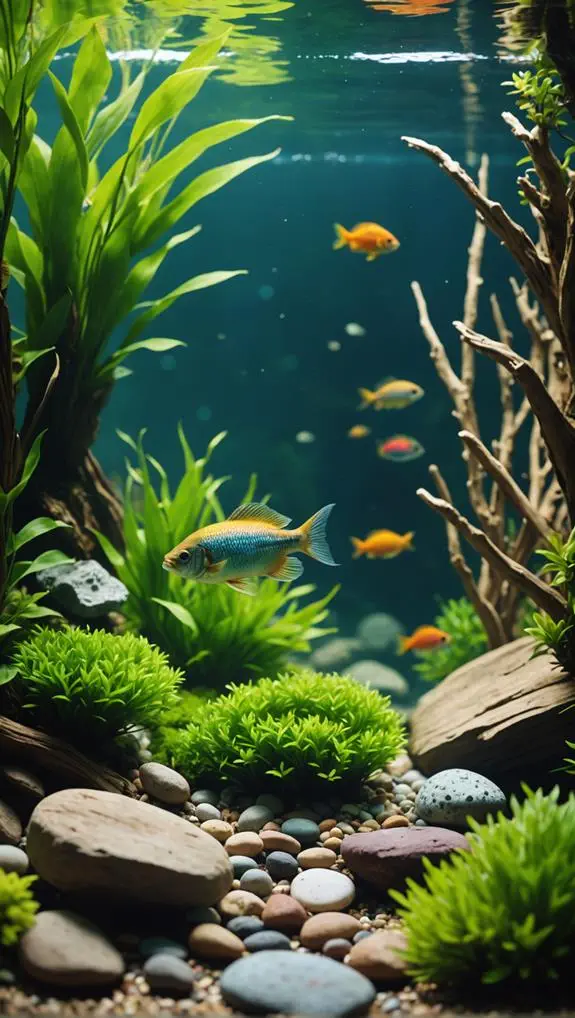
Creating a natural environment in your fish tank is essential for the well-being of your aquatic pets. When you set up your tank, think about how you can mimic their natural habitat. This not only makes your fish happy but also enhances the beauty of your aquarium.
Here are some tips to get you started:
- Choose the right substrate: Use gravel for community fish or sand for bottom dwellers like catfish.
- Incorporate live plants: They provide shelter and improve water quality. Anubias, Java Fern, and Amazon Sword are great options!
- Add natural decorations: Look for rocks, driftwood, and caves that are aquarium-safe and rinsed clean.
- Create distinct zones: Group your plants and decorations to offer a sense of security for your fish.
- Support beneficial bacteria: This helps maintain a balanced ecosystem and keeps your fish healthy.
Cycling the Aquarium
Cycling your aquarium is a crucial step in ensuring a healthy environment for your fish. This cycling process typically takes 1-3 months and helps establish beneficial bacteria that keep toxic ammonia and nitrites at bay.
You've got two main methods to choose from: fishless cycling, which is safer for your aquatic friends, or fish-in cycling, which can be risky and needs daily monitoring.
If you want to avoid stressing your fish, fishless cycling is the way to go. By introducing beneficial bacteria without fish, you're creating a safe haven for them.
During this time, regularly test your water quality, aiming for nitrite and ammonia levels at 0, with nitrates below 20. Liquid test kits are your best friends here for accuracy.
Also, consider using media or substrate from an established tank to speed things up.
And don't forget those weekly water changes! A 50% change helps maintain water quality while supporting the nitrogen cycle.
Introducing Fish Safely
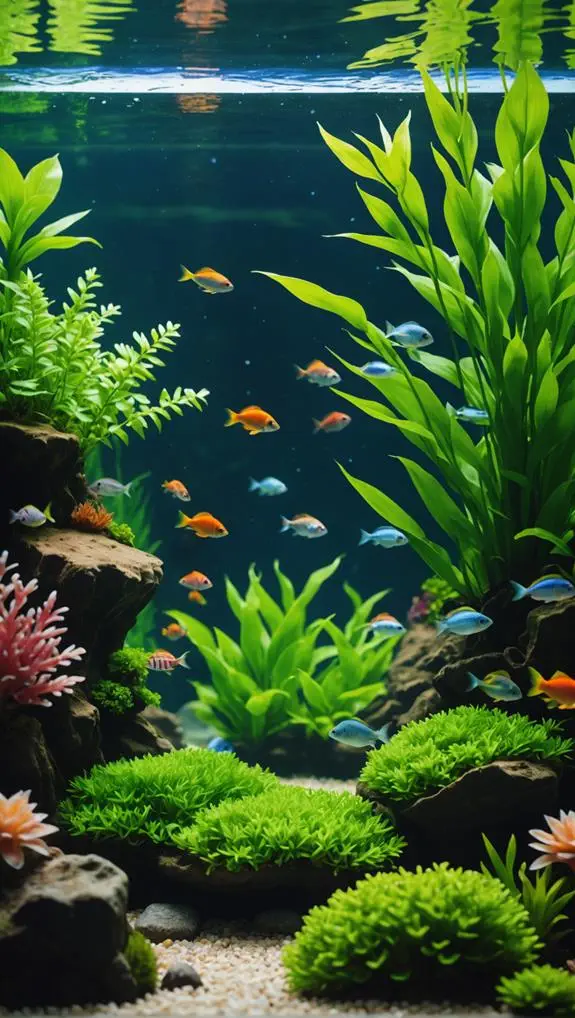
Once your aquarium has completed the cycling process, it's time to introduce fish safely. This step is crucial for ensuring your aquatic friends thrive in their new home.
Start by quarantining new fish in a separate tank for at least two weeks. This helps prevent any sneaky diseases from spreading to your established aquarium.
Here are some tips to make the introduction smooth:
- Ensure stable water parameters before adding fish.
- Introduce fish gradually—start with 1 to 2 hardy species.
- Use the drip acclimation method to help your new fish adapt to the tank's water chemistry.
- Monitor fish behavior closely for signs of stress or disease.
- Wait at least a month before adding more fish to avoid overwhelming the system.
Ongoing Maintenance Practices
Maintaining a healthy aquarium requires regular attention and care to ensure your fish thrive. Start by changing 10-25% of the water every 2-4 weeks. This helps keep water quality high and reduces toxins from fish waste. You'd be surprised how much better your aquatic buddies feel with clean water!
Weekly water testing is essential. Check your pH, ammonia, nitrite, and nitrate levels. Aim for ammonia and nitrite at 0, and keep nitrates below 20—think of it as a health check-up for your tank.
Don't forget about your filter media! Replacing it monthly will ensure efficient filtration and a happier fish community.
Now, let's tackle algae control. Maintain appropriate light levels and consider adding some algae-eating fish or invertebrates; they'll do the dirty work for you.
Finally, don't skip daily checks on your filter and heater. These little routines can prevent equipment failures that could stress out your fish.
With a little love and attention, your aquarium won't only survive but flourish! After all, happy fish make for a happy home, and isn't that what we all want?
Frequently Asked Questions
How to Properly Set up a Fish Tank?
To properly set up a fish tank, choose suitable substrate options, install tank equipment like filtration systems, select appropriate lighting types, and consider fish compatibility. Establish maintenance routines to ensure a thriving aquatic environment for your fish.
How Long Should a Fish Tank Be Set up Before Putting Fish In?
Did you know that 40% of new fish die within the first month? To avoid this, set up your tank for at least 1-2 weeks, focusing on substrate selection, water quality testing, and filtration system types.
How Long Should You Let a Fish Tank Cycle Before Adding Fish?
You should let your tank cycle for 1-3 months to establish beneficial bacteria. Monitor ammonia levels and nitrate buildup. Consider fishless cycling for safer tank maintenance, ensuring a healthy environment for your future fish.
How Long Should Water Sit Before Adding to Fish Tank?
Letting water sit feels like waiting for a millennium, but ideally, you should let it rest for 24 hours. Use dechlorination methods for immediate use, ensuring proper water temperature, pH levels, and filtration options for your tank size.
Final Thoughts
Now that you've set everything up, the true adventure begins! Your fish are ready to dive into their new home, but will they be as excited as you are? Keep an eye on them, and don't forget to enjoy every moment. As you watch them swim and explore, remember that a little patience goes a long way. With the right care and attention, your fish tank will flourish, and you might just find yourself hooked on this captivating hobby!

